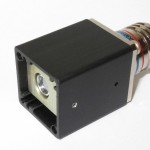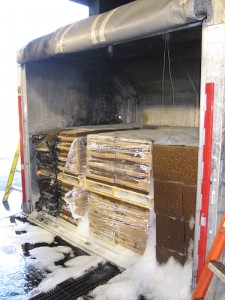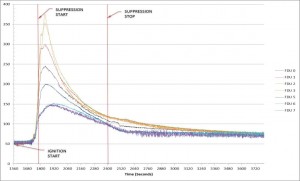Thermal Monitoring Systems
DETECTING FIRE FASTER
 The Ventura Aerospace Fire Suppression System utilizes infrared technology to detect temperature rises in the cargo loaded into a cargo compartment. This technology allows for very rapid detection regardless of the smoke quantity being generated.
The Ventura Aerospace Fire Suppression System utilizes infrared technology to detect temperature rises in the cargo loaded into a cargo compartment. This technology allows for very rapid detection regardless of the smoke quantity being generated.
The system is also able to locate the fire within the cargo compartment. It does this by utilizing an array of sensors located above each container position in the cargo compartment. These non-contact-based sensors simply look at the container or palletized freight and measure a temperature rise. While this system is integrated into the Fire Suppression System, it can easily be used to stand alone.

With a quick detection time suppression is possible on Lithium-Ion batteries inside laptops.
The thermal monitoring system is able to detect a fire four minutes after ignition. The amount of smoke being generated at this point is relatively low and may not be detectable by a one-minute-rule smoke detection system. A five-minute-rule smoke detection system would not have the chance at detecting a fire this early.
Through the use of early detection, suppression is much more achievable on even the most difficult fires. A full-scale live fire test using over 90 typical laptops was conducted at the Ansul burn test facility in Marinette, WI. The fire was started in one laptop by inducing a thermal runaway in the battery. At least 10 laptops were involved in the fire before suppression was achieved.
Cargo load shift had also begun as the packaging along the bottom had lost its integrity. If the load shift was allowed to continue it might be possible for the cargo to spill out of the container. This is particularly relevant to lightweight or plastic containers as those containers offer little or no fire resistance. Spilling of burning freight may allow the fire to propagate faster or involve aircraft systems and structure.
The FAA requirement to provide a visual indication to the flight crew within one minute after the start of a fire does not take into account a fire within a container. Testing of cargo compartments is done with the compartment empty using a smoke generator. Turning the smoke generator on is considered the ignition time of the fire.
Smoke detection systems are able to detect a fire within 20-30 seconds usually as the smoke has the freedom to rise up to the smoke detectors. In the real world, fires occur inside containers, where smoke is trapped. It takes several minutes for significant amounts of smoke to escape a container and trip the smoke detectors.
Thermal detection can be used in conjunction with smoke detection to provide a better method for fire detection. In addition to providing an alternate means of detection, the known location of the fire is now achievable.

